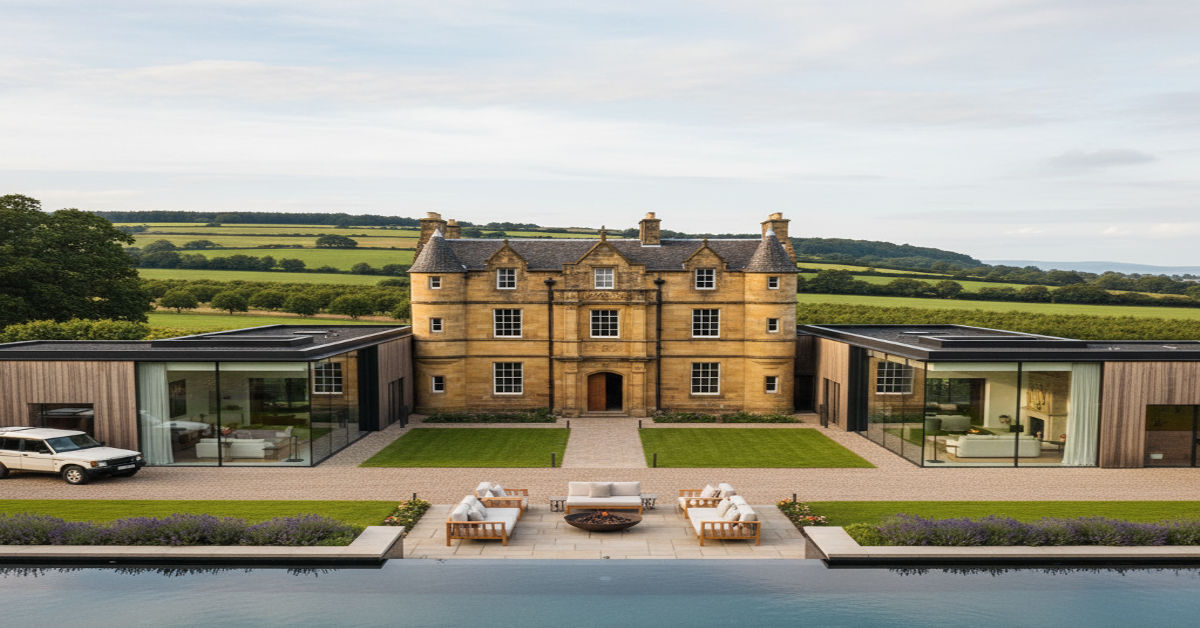Luxury countryside living in Culross is more than simply owning property in a picturesque village—it is an experience that weaves together centuries of history, craftsmanship, and quiet refinement. The village itself, with its cobbled lanes and warm-hued cottages, reflects a harmony between people and place that modern developments rarely achieve. For those seeking sanctuary within Scotland’s serene landscapes, Culross represents an exceptional blend of rural peace and architectural poetry.
This rare combination of heritage and elegance defines what makes Culross so captivating. Beyond the charm of its streets lies an enduring lifestyle that embraces simplicity and sophistication alike. From hidden courtyards to panoramic gardens overlooking the Firth of Forth, life here feels timeless yet deeply connected to the present. In this article, we’ll explore how to embrace luxury countryside living Culross—where history becomes home and comfort coexists with culture.
The Allure of Culross as a Countryside Retreat
Tucked on the northern shore of the Firth of Forth, Culross feels like a preserved fragment of Scotland’s past. Its whitewashed walls and steep, narrow wynds invite exploration, while the air carries a quiet that calms the spirit. The charm lies not in grandeur but in grace: homes seem to emerge organically from the land, and the gentle rhythm of daily life still follows the turn of tides and seasons.
Living in Culross is as much about environment as architecture. The surrounding fields and woodlands stretch toward the hills, offering privacy and panoramic beauty without sacrificing accessibility. Whether you stroll to the local café or gaze across the estuary at sunset, the balance of seclusion and connection defines its unique appeal. Those seeking luxury countryside living Culross will find that refinement here does not disrupt the landscape—it enriches it.
A Living History: Origins, Character, and Preservation
Culross began as a medieval monastic settlement before flourishing as a prosperous 16th-century trading port. Its cobbled lanes, painted houses, and the iconic Culross Palace—restored under the care of the National Trust for Scotland—stand as living testaments to craftsmanship and community. These preserved streets have earned Culross recognition as one of Scotland’s most authentic historic burghs, maintaining its early urban plan almost intact.
Preservation here is more than cosmetic; it’s a philosophy. Buildings are maintained using traditional materials—limewash, slate, and local stone—ensuring their textures age gracefully. The Trust’s restoration work balances authenticity with comfort, discreetly integrating modern amenities while safeguarding each structure’s narrative. Residents become stewards as much as owners, contributing to a shared vision of sustainable heritage living.
Defining Luxury in a Historic Rural Setting
Luxury in Culross is quiet and contextual. It emerges through craftsmanship, proportion, and the interplay of light with old stone walls. Rather than flaunting wealth, homes express refinement through restraint—thick wooden doors, open hearths, and the tactile warmth of natural materials. Interiors often reveal centuries-old beams paired with contemporary fittings, uniting durability with design sophistication.
In this setting, true luxury means balance: between modern convenience and historical authenticity, between solitude and sociability. Expansive gardens, elegant drawing rooms, and serene courtyards transform living into an art form. A well-conceived home here doesn’t overpower its surroundings; it complements them, drawing on Culross’s timeless character to create something deeply personal.
Types of Luxury Properties Around Culross
Luxury properties in and around Culross range from centuries-old burgh houses to secluded countryside estates. Each offers a distinct way to experience the area’s tranquil beauty. Within the village, restored cottages and merchant houses provide charm and intimacy. Beyond its edges, renovated farm steadings and modern eco-retreats unfold into rolling landscapes, offering more space and freedom.
For those evaluating investment or lifestyle choices, the following table outlines the main categories of luxury properties found in the Culross area and their defining traits.
| Property Type | Key Features | Advantages | Considerations |
| Historic Burgh Houses | 17th–18th-century architecture, stone façades, village centre location | Authentic atmosphere, walkable amenities | Limited space, conservation restrictions |
| Converted Steadings | Large internal volumes, exposed beams, rural outlook | Privacy, generous gardens, blend of old and new | Distance from shops, higher maintenance |
| Country Estates | Expansive acreage, outbuildings, landscaped grounds | Total seclusion, long-term value | High management and upkeep costs |
| Modern Eco-Retreats | Contemporary builds with sustainable systems | Energy efficiency, modern layouts | Limited availability, stricter planning oversight |
Each option reflects a lifestyle choice—from community immersion to complete countryside solitude. Whichever you choose, the constant is Culross’s sense of place and continuity.
Architecture, Conservation and Sensitive Design
Architectural work in Culross requires a delicate hand. Because much of the village lies within a conservation area, any alteration must respect its historical character. Guidance from Historic Environment Scotland ensures that new interventions enhance rather than diminish the heritage fabric. Design excellence here means integrating technology and comfort without visual disruption.
To achieve this harmony, homeowners and architects often rely on specialized materials and discreet methods. Secondary glazing, breathable insulation, and hidden wiring preserve both performance and aesthetics. The following table summarizes strategic approaches for balancing modern systems with heritage integrity.
| Design Aspect | Recommended Approach | Preservation Benefit |
| Energy Efficiency | Use internal wall insulation with vapor-permeable materials | Prevents trapped moisture in old masonry |
| Lighting | Employ concealed LED tracks and warm tones | Enhances ambience while respecting texture |
| Heating Systems | Opt for ground or air-source heat pumps with underfloor delivery | Maintains clean wall surfaces |
| Additions | Use glass link corridors or reversible extensions | Protects original structure integrity |
| Materials | Match lime mortars, natural stone, timber joinery | Maintains authenticity and continuity |
Through such measures, homeowners achieve comfort that feels intrinsic rather than imposed—luxury born from respect for heritage.
Gardens, Grounds and the Outdoor Lifestyle
Culross’s gardens reveal the artistry of balance between cultivation and nature. The Culross Palace Garden, recreated using 17th-century planting schemes, stands as an inspiration for those designing private landscapes. Its terraces and herbal borders remind residents that beauty and utility can coexist effortlessly. A luxury garden here often becomes a living extension of the home—a place for reflection, celebration, and seasonal rhythm.
Designing such landscapes involves layering: structural frameworks, edible gardens, and wild edges that blend seamlessly with the environment. Maintenance remains a central consideration, ensuring elegance endures beyond initial installation. The table below helps visualize key landscape elements and their upkeep needs.
| Element | Typical Size | Seasonal Care Requirements | Aesthetic Value |
| Formal Terraces | 0.1–0.3 acre | Regular pruning, edging, cleaning | Creates order and architectural balance |
| Herb & Kitchen Garden | 0.05 acre | Weekly tending, soil renewal | Adds fragrance and functionality |
| Woodland Edge | 1 acre | Annual thinning, path repair | Enhances biodiversity and privacy |
| Water Feature | 100–300 m² | Filtration checks, algae control | Reflects light, calms atmosphere |
| Meadow Lawn | 0.2 acre | Periodic mowing, reseeding | Evokes natural countryside character |
By treating gardens as evolving artworks, residents craft outdoor environments that mirror Culross’s harmony between history and the land.
Practical Infrastructure for Seamless Rural Living
Behind every serene country home lies careful infrastructure planning. Modern luxury demands reliable power, heating, and connectivity. Culross’s historic environment requires subtle integration—solar panels tucked behind roof ridges, underground utilities, and discreet parking solutions that preserve visual integrity. Achieving rural comfort without disturbing the landscape reflects the new definition of refinement.
Connectivity, once a limitation, is now achievable through fibre broadband and satellite solutions. Smart home systems can operate invisibly, automating lighting, temperature, and security. When executed properly, these features complement the timeless calm of countryside living, ensuring that elegance is matched by effortless function.
Community Life, Culture and Year-Round Rhythm
Life in Culross flows with a quiet rhythm. Locals and newcomers alike gather for heritage walks, village markets, and cultural events organized in partnership with the National Trust for Scotland. This community fosters connection rather than isolation—a hallmark of authentic countryside living. Residents share a collective respect for preservation, sustaining the village’s character through participation and pride.
Seasons define experience here. Spring brings blossom along the Forth; summer fills the streets with visitors drawn by Culross’s cinematic charm, seen in productions like Outlander. Autumn’s golden light transforms the lanes, while winter settles into contemplative stillness. A luxury home in Culross feels different each season, always intimate yet renewed by change.
Market Dynamics and Investment Considerations
Property demand in Culross remains steady, driven by rarity, aesthetics, and the reliability of heritage oversight. Buyers often view these homes as long-term investments—emotional as much as financial. Managed stewardship by trusted organizations such as the National Trust for Scotland ensures lasting value.
Still, investors must balance returns against maintenance and compliance costs. The next table outlines various ownership and use models relevant to luxury countryside living Culross.
| Ownership Model | Revenue Potential | Complexity Level | Best For |
| Private Residence | Low | Minimal | Long-term personal enjoyment |
| Seasonal Retreat | Moderate | Moderate | Part-time residents or holidaymakers |
| Boutique Guest House | High | High | Hospitality investors seeking charm and story |
| Heritage Let | Moderate | Moderate | Short-term income with preservation value |
| Event Venue | Very High | Very High | Those ready for management and planning commitments |
Each path offers distinct rewards. For many, the real return lies in the privilege of living within beauty that endures beyond a lifetime.
Common Challenges and How to Prepare for Them
Preserving historic properties along Scotland’s coast demands diligence. Damp control, masonry care and roofing integrity remain constant priorities. Expert trades familiar with lime mortar, lead flashing, and stone repair are essential. Neglecting such details can escalate minor wear into major structural concern. Maintaining the authenticity of materials while preventing weather damage defines responsible ownership.
Equally important is navigating the consent process. Historic Environment Scotland regulates alterations to listed buildings, and compliance protects both property and heritage status. Engaging heritage architects early ensures proposals align with conservation principles, saving time and preserving peace of mind.
Conclusion
Luxury countryside living Culross is not about grandeur—it’s about grace. It’s about waking to the sound of the Forth’s tides, tending a garden that changes with the seasons, and resting within walls that have seen centuries pass yet still feel alive. In this village, heritage and modernity dance together quietly, crafting homes that whisper rather than shout their worth.
For anyone seeking a life shaped by authenticity, beauty, and stillness, Culross offers something rare: the opportunity to live inside history without being trapped by it. It is a place where luxury is measured not by scale but by soul—a countryside existence defined by depth, texture, and the enduring rhythm of place.







